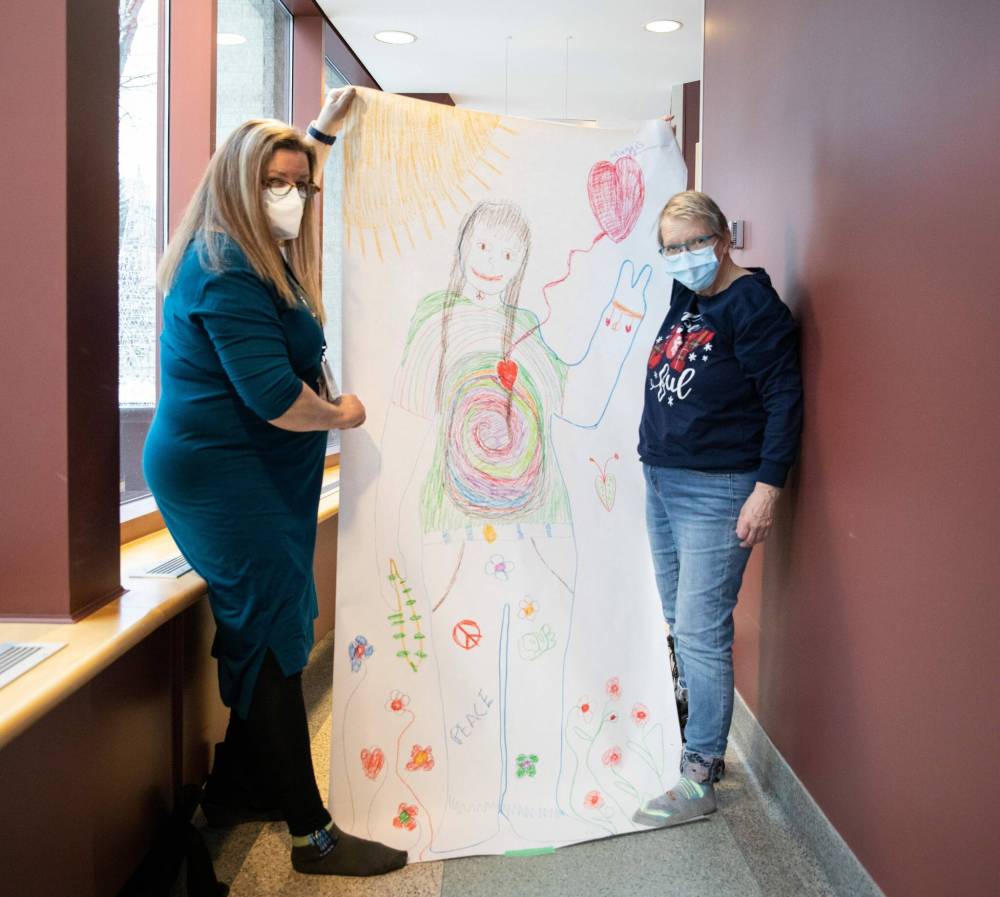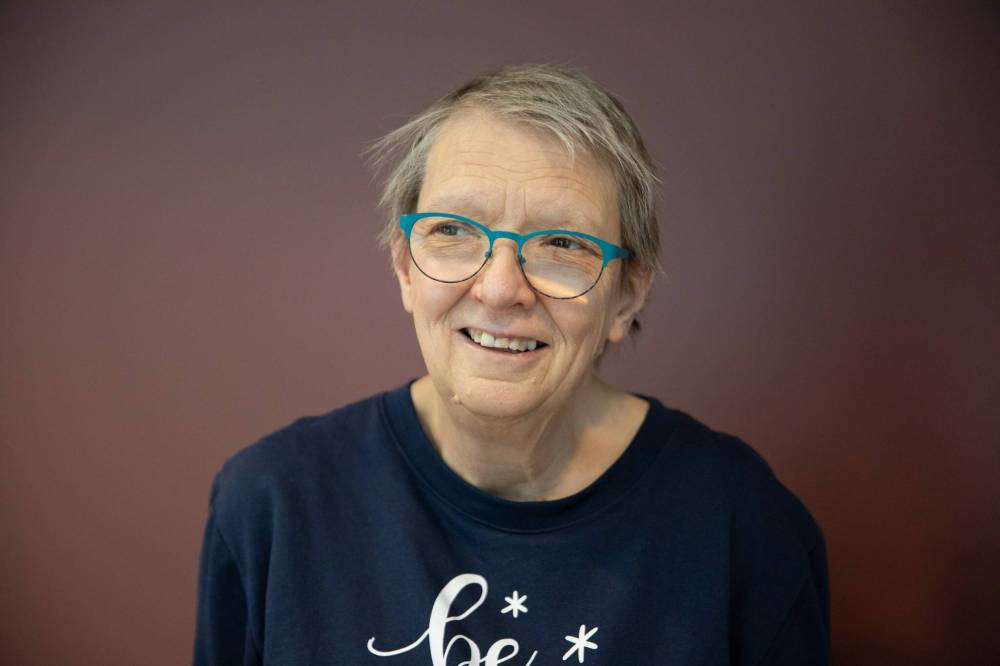Create and connect CancerCare therapy program encourages participants to use art to explore feelings, process emotions
Read this article for free:
or
Already have an account? Log in here »
To continue reading, please subscribe:
Monthly Digital Subscription
$0 for the first 4 weeks*
- Enjoy unlimited reading on winnipegfreepress.com
- Read the E-Edition, our digital replica newspaper
- Access News Break, our award-winning app
- Play interactive puzzles
*No charge for 4 weeks then price increases to the regular rate of $19.00 plus GST every four weeks. Offer available to new and qualified returning subscribers only. Cancel any time.
Monthly Digital Subscription
$4.75/week*
- Enjoy unlimited reading on winnipegfreepress.com
- Read the E-Edition, our digital replica newspaper
- Access News Break, our award-winning app
- Play interactive puzzles
*Billed as $19 plus GST every four weeks. Cancel any time.
To continue reading, please subscribe:
Add Free Press access to your Brandon Sun subscription for only an additional
$1 for the first 4 weeks*
*Your next subscription payment will increase by $1.00 and you will be charged $16.99 plus GST for four weeks. After four weeks, your payment will increase to $23.99 plus GST every four weeks.
Read unlimited articles for free today:
or
Already have an account? Log in here »
Hey there, time traveller!
This article was published 09/01/2023 (1064 days ago), so information in it may no longer be current.
Art has given Maggie Hodson a lot in the last five years.
Exhibit preview
I’m Still Here
• Jan. 19, 10 a.m. to 4 p.m.; Jan. 20, 9 a.m. to 3 p.m.
• CancerCare Manitoba, 675 McDermot Ave., 2nd Floor atrium
• Visit cancercare.mb.ca for more information
Something to do with her hands between chemotherapy sessions and doctor appointments. An outlet to document daily life post-lumpectomy. A safe space to process the fears, frustrations and unknowns of a breast cancer diagnosis.
It’s even allowed her to travel back in time.
“I went back to the ’70s,” she says, unfurling a large piece of white paper that’s as long as she is tall. The canvas is filled with a colourful sketch of a girl in a tie-dyed shirt surrounded by flowers and butterflies. A bright yellow sun is shining in the upper left corner. “I put the peace signs and the long hair — I had long hair back then and granny glasses, the whole bit.”
Hodson was a teenager in Killarney in the 1970s and enthralled with the hippie movement unfolding beyond her small hometown in western Manitoba. It was a younger, carefree version of self Hodson was keen to revisit during an art therapy class at CancerCare Manitoba.
“Every day was summer, the sky was blue,” she says. “Nothing had touched us yet.”
During this particular class, participants were asked to take part in a body scan — a mindfulness exercise to suss out thoughts and feelings associated with different body parts. Those revelations were then turned into life-size art pieces.
Much of the work in CancerCare’s Expressive Art Group is focused on reconnecting with a body that no longer feels like home following cancer treatment.
JESSICA LEE / WINNIPEG FREE PRESS Group leader Miriam Duff (left) and patient Maggie Hodson display Hodson’s life-size ‘body scan’ artwork.
“For some people, they describe feeling very fragmented and very separated from their body, distrustful,” says psychosocial oncology clinician Miriam Duff, who has been facilitating art classes since 2009. “The pressure gets released a bit by expressing yourself, by pushing the colours onto the paper and making choices.”
CancerCare’s art program celebrated its 20th anniversary last year. Participants meet online for a few hours every week during the 10-week session, which is open to adults who have been diagnosed and treated within the past two years.
Duff, who is a glass artist, likes to start each class with a sensory check-in activity, either with musical instruments or sketching. Group members are invited to explore different media — clay, paint, collage, pastels — and there are plenty of opportunities to talk about life with cancer.
“There’s these wonderful communities of support amongst people who have this lived experience,” Duff says. “People really became compassionate towards one another and learned to be compassionate to themselves.”
“It was certainly different every week,” Hodson adds. “Sometimes people were sad, sometimes people cried, sometimes they were happy.”
Supplied After being diagnosed with breast cancer, Maggie Hodson created a quilt with 365 squares documenting her treatment experience. 
Above all, the group is about connection without judgment — artistic and otherwise.
“It’s not about being good enough, it’s just about being here,” Duff says. “People can create and experiment without worrying about the end product.”
Recently, the Expressive Art program was the subject of a research study to evaluate the effectiveness of mindfulness-based art therapy for cancer patients. The study, led by Trinity Western University professor Dr. Kendra Rieger, described the group as an effective and unique way for patients to calm anxieties and process difficult emotions.
“It very much lined up with what I understood,” Duff says of the findings. “This (can be) a transformative process for people.”
Later this month, CancerCare is hosting an art exhibit, titled I’m Still Here, of work created by study participants. The show is open to the public and will include a guided audio tour highlighting the meaning behind each piece.
For Hodson, the group has allowed her to take things one step at a time and trust the process (of healing and making art). She’s also been inspired to continue with her own art practice.
JESSICA LEE / WINNIPEG FREE PRESS Maggie Hodson, who was diagnosed with breast cancer in 2017, says CancerCare’s art program inspired her to expand her own art practice. 
After being diagnosed with breast cancer in 2017, she was looking for something to fill her days during recovery. Writing in a diary felt daunting and the counting required for knitting took too much brain power. A lifelong sewer, she turned to quilting.
Over the course of a year, she created a massive quilt, 365 squares in total, that tells the story of her cancer journey. Set on a blue sky background, Hodson sewed all things and figures that featured prominently in her life post-diagnosis — there’s a square for chemotherapy; cannabis; yoga; Rusty, St. Boniface Hospital’s longtime bespectacled therapy dog; and, of course, the Expressive Art building.
The quilt is on display at Westminster United Church, where Hodson is a congregation member.
She’s currently working on turning the body scan she made in the program into a quilt.
“I have to learn how to sew the hair,” Hodson says. “Then I can cut the rest of her out and get busy.”
eva.wasney@winnipegfreepress.com
Twitter: @evawasney

JESSICA LEE / WINNIPEG FREE PRESS
Miriam Duff, a glass artist and psychosocial oncology clinician, leads the weekly Expressive Art Group through CancerCare.

Our newsroom depends on a growing audience of readers to power our journalism. If you are not a paid reader, please consider becoming a subscriber.
Our newsroom depends on its audience of readers to power our journalism. Thank you for your support.
History
Updated on Tuesday, January 10, 2023 9:04 AM CST: Adds web headline






